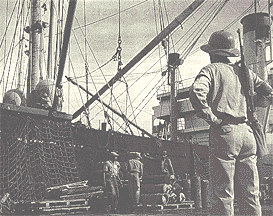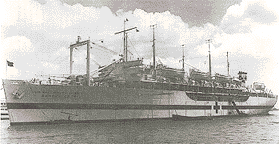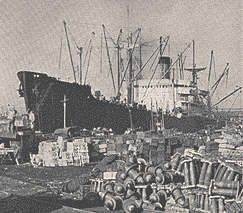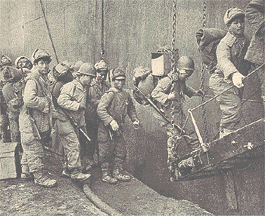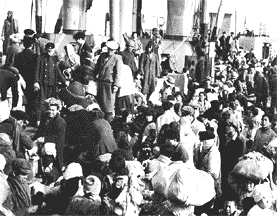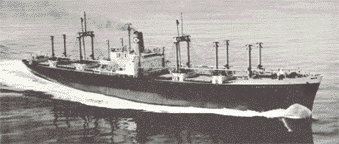Korea: The First Shot
(Military Sea Transportation Service in Korean War)By Salvatore R. Mercogliano
In January of 1950, Captain Alexander F. Junker (USN) arrived in Tokyo, Japan to oversee the transfer of Army Transport Service personnel and ships to the newly established Military Sea Transportation Service (MSTS).
Set to take place on July 1, Junker could not anticipate the magnitude of his assignment when six days prior to his assumption of command, forces of the Democratic People's Republic of Korea crossed the 38th parallel and invaded the Republic of Korea.
President Harry S. Truman's decision to commit U.S. forces and to expand the Mutual Defense Assistance Program to South Korea forced Junker, and his fellow MSTS commander on the West Coast, Captain William R. Thayer to divert every possible ship to the Far East to support this effort. Junker immediately ordered the coastal transport USAT Sgt. George D. Keathley and the cargo ship USNS Cardinal O'Connell from their scheduled duties to transport vital ammunition to Pusan.
While the Commander of MSTS, Rear Admiral William M. Callaghan, and his staff coordinated the efforts of his regional deputies, the immediate need was to sealift combat forces to the Korean peninsula to stem the tide of North Korean aggression. Aircraft of the Military Air Transportation Service could not lift the necessary forces and its was up to MSTS, ships of the commercial U.S. merchant marine, and those broken out of the National Defense Reserve Fleet (NDRF) to sustain the United Nation's effort in Korea.
By July 6, 1950, only 11 days after the initial invasion, MSTS was able to deploy the 24th Infantry Division from garrison duty in Japan, to the port of Pusan in South Korea. Two other divisions from Japan, the 25th Infantry and the 1st Cavalry Division were put ashore by the middle of that month.
However, these forces alone proved insufficient and MSTS demonstrated its versatility and capability to the military by deploying the 2d Infantry Division from its home station in Fort Lewis, Washington to Korea, in only 29 days, from July 17 to August 19, 1950. This movement required the use of 10 MSTS troop transports and 11 cargo ships, all but one a commercially chartered ship.
Unloading military cargo in Korea from MSTS-chartered shipThe commercial merchant marine formed the backbone of the bridge of ships across the Pacific. From just 6 ships under charter when the war began, this total peaked at 255. Over 85 percent of all the cargo shipped to Korea by sea came on board U.S. commercial shipping.
To initially fill the urgent shortfall in shipping, MSTS activated ships from the National Defense Reserve Fleet. Some of these ships were utilized as part of the nucleus fleet and crewed by Civil Service merchant mariners. These included 12 transports, 6 cargo ships, 5 escort carriers (outfitted as aircraft transports), and 35 tankers.
Additionally, MSTS was given the responsibility for crewing two hospital ships being deployed to Korea. While undergoing its initial sea trials, and before its full civilian crew could be embarked, the USS Benevolence (T-AH 13) was rammed and sunk by the SS Mary Luckenbach off San Francisco on August 25, 1950. Out of a crew of 505, 23 died including the prospective master of the ship, Captain William "Pineapple Bill" Murray.
Hospital ship USS Benevolence (T-AH 13) C4-S-A3However, the USNS Repose (T-AH 16) did deploy with 168 civilian mariners on board and remained on station till October 28, when a naval crew replaced the merchant mariners. During their 32 days on station, the ship received and treated over 1,200 patients.
In addition to the ships assigned directly to MSTS, 130 laid-up Victory ships in the NDRF were broken out by the Maritime Administration and assigned under time-charters to private shipping firms, for charter to MSTS.
Since the United Nations sanctioned the action in defense of the Republic of Korea, other nations offered troops to serve on the peninsula, but many of them lacked the capability to deploy them, and MSTS served as a conduit. In 1951, the USNS General J. H. McRae, a C-4 "General" class troop transport, that served for MSTS Atlantic, operated between the ports of New York and Bremerhaven.
However with the crisis in Korea, MSTS altered its return voyage, and added several stops. From Bremerhaven, the ship called on the ports of Rotterdam, Piraeus, Djibouti, and finally Pusan where it delivered troops from the Netherlands, Belgium, Greece, and Ethiopia, before returning back to New York with 2,000 veterans, and an additional 1,168 European refugees. All told the McRae sailed over 32,000 miles in 96 days.
Ships of the MSTS not only provided supplies but also served as naval auxiliaries. When the U.S. X Corps went ashore at Inchon in September 1950, 13 USNS cargo ships, 26 chartered American, and 34 Japanese-manned merchant ships, under the operational control of MSTS, participated in the invasion.
